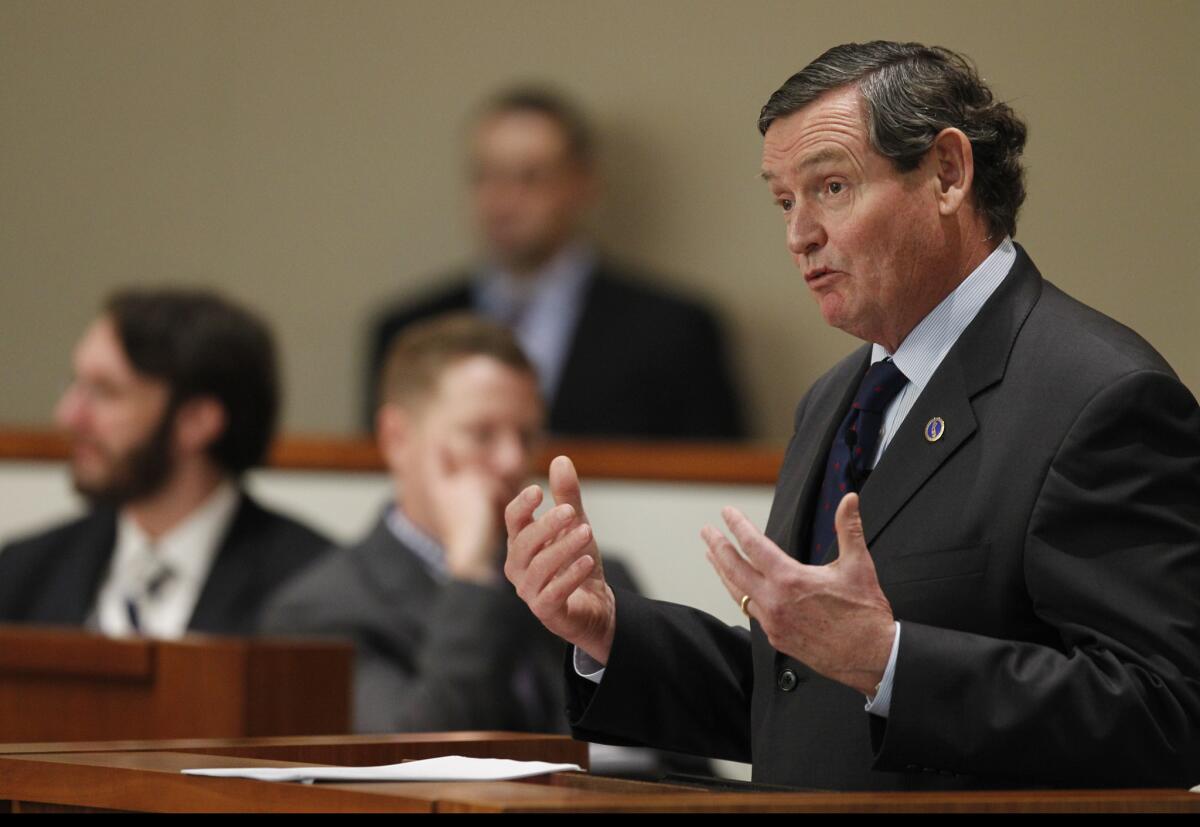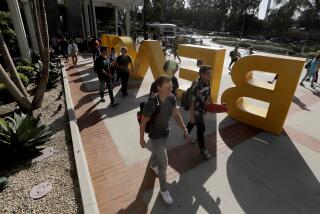Graduation rates are on the agenda as Cal State trustees meet in Long Beach

With Gov. Jerry Brown in attendance, CSU Chancellor Timothy P. White delivers a “State of CSU” address to the California State University Board of Trustees.
- Share via
The message from Gov. Jerry Brown in his latest budget proposal could not have been more clear: Cal State schools are not graduating enough students within four years.
To emphasis the point, his budget summary included a chart with four-year graduation rates for freshmen at each of the system’s 23 campuses. All but three were below the national average of 34% for public universities.
The governor wants Cal State — and the University of California, for that matter — to send more funds to campuses that are improving their graduation rates and reducing disparities between students from different ethnic and socioeconomic backgrounds.
That controversial proposal awaits the Cal State Board of Trustees as they begin two days of meetings in Long Beach today.
Among other items of interest are expected to be faculty demands before the Trustee’s Collective Bargaining Committee to resolve a long-running stalemate over salary negotiations. The faculty union wants a 5% across-the-board increase, while Cal State management is offering 2%.
And students are scheduled to ask trustees to reject recommendations by a university panel studying long-range planning that call for annual tuition hikes and year-round academic schedules.
Trustees may also announce new presidential appointments for the San Jose and Sonoma campuses.
Chancellor Timothy P. White is scheduled to present his annual overview of the nation’s largest four-year university system. Expect him to discuss enrollment, tuition, budget concerns, faculty hiring and various system-wide initiatives aimed at improving student success.
In a separate presentation, trustees will get an update on White’s initiative to reduce the time it takes students — both freshmen and transfers — to obtain a degree. By 2025, the goal is to have a six-year freshman graduation rate of 60% (up from 57% now) and a four-year graduation rate of 24% (up from 17%).
The target two-year graduation rate for transfer students who enter Cal State as juniors would jump to 35% from 27%. The plan also calls for reducing ethnic and income gaps.
The goals are “commendable,” but they fall short, according to Brown.
“The trustees’ sustainability plan based its goals on the continuation of past trends rather than setting more ambitious graduation rates,” the governor stated in his budget summary. “Given the magnitude of these challenges and their real impacts on students each year, this work must be done more quickly.”
Brown’s budget proposal provides no guidance on what targets he would find acceptable — the details are up to White and the trustees, said H.D. Palmer, a spokesman for the Department of Finance.
But Palmer pointed out that schools that Cal State considers comparable for the purposes of setting executive compensation do a far better job of graduating their students in a reasonable amount of time.
For instance, in 2013, the four-year freshman graduation rate was 65% at James Madison University in Virginia, 44% at Illinois State University and 40% at Western Washington University, according to the budget report. Comparable rates at Cal State ranged from 49% at the California Maritime Academy to 6% at the Dominguez Hills campus, the report said.
The system-wide average is 17%.
That comparison is unfair, said Eric Forbes, Cal State’s assistant vice chancellor for student academic services. The 2013 figures for Cal State reflect campuses struggling to overcome funding cuts, reductions in classes, faculty layoffs and other hardships brought on by the recession, he said.
To make significant improvements in the four-year rate will be a a heavy lift and will take several years, he acknowledged.
The system already is upgrading advising programs at all campuses and redesigning some courses to reduce bottlenecks, among other strategies to move students through more quickly.
The biggest key is making sure students admitted to Cal State are better prepared for college-level math and English classes. Remedial courses, which do not count toward a degree, can add a year or more to studies, Forbes said.
Many educators at Cal State and elsewhere criticize the narrow focus on graduation rates, contending they don’t accurately measure campus performance. That’s especially true in a system such as Cal State, where many students work and take less than a full load of units.
At Dominguez Hills, for example, 30% of students attend part time and 80% require remedial classes, said William Franklin, vice president of student affairs at the campus.
More than half of students are the first in their family to attend college, and two-thirds are community college transfers.
Investments in peer mentoring and advising programs are “moving the needle,” Franklin said. The six-year graduation rate for students who entered the school in 2010 is projected to be 43%, up from 28% only a few years ago, he said. And retention of students after their first year is 81%, the highest in many years, Franklin said.
“The metrics of four-year and six-year graduation rates are great indicators, but at the end these are students and folks who deserve to get to the finish line,” Franklin said.
Follow me on Twitter @carlariveralat
ALSO
The problem with your lottery tickets and school funding
Is El Niño wimping out in Southern California? Not quite
This South L.A. corner is no place for ex-inmates to reenter society, critics say
More to Read
Sign up for Essential California
The most important California stories and recommendations in your inbox every morning.
You may occasionally receive promotional content from the Los Angeles Times.











